#especially after that movie script I needed to clean my palette
Text

Them!!
#art#digital art#fantasy#dragon#spyro the dragon#spyro reignited trilogy#sparx#I’m on a massive nostalgia binge#I had to draw them#especially after that movie script I needed to clean my palette#also ignore my shitty ass handwriting for my signature I can’t write for shit atm#also I love the art style for the reignited trilogy so much I especially the shading/use of colours so I had to try it out
98 notes
·
View notes
Text
Episode 13: His Girl Friday & Roman Holiday
Please consult these Instagram slideshows for accompanying images:
His Girl Friday
Roman Holiday
Both:
Welcome to The Costume Plot.
Jojo:
I'm Jojo Siu.
Sarah:
and I'm Sarah Timm. We're professional designers with a passion for costume design and the performing arts. Our podcast does contain spoilers.
Jojo:
We hope you'll join us every other week as we delve into the wonderful world of costume design in The Costume Plot. [music]
All right.
Sarah:
[sings] Welcome back, welcome back.
Jojo:
Welcome to The Costume Plot. [both laugh]
Sarah:
It's us again!
Jojo:
Yaaaay! what are we on now? Month four, five?
Sarah:
Good question. Yeah?
Jojo:
I've lost track. It means we're that far in.
Sarah:
and we're still enjoying it...
Jojo:
That's a good sign.
Sarah:
...which is good.
Jojo:
Yes. Some little bits of homework, but at least we're enjoying the process.
Sarah:
Hey, it's-- every time I'm like, "Oh, no, I have to sit down and watch that movie," I end up really enjoying myself. And I do my research. And I like the research part. So I'm still having fun. Even sometimes I forget to make time to do it. [both laugh]
Jojo:
It's true. All right. So today, our theme is going to be black and white movies.
Sarah:
Yeah.
Jojo:
We haven't really covered this yet. So this is kind of a new platform to talk about costumes. And one of the things that we are going to talk a lot about, or I assume we're going to talk a lot about, Sarah, is that, you know, how do we do costumes? And how do we differentiate characters when you're limited to a color palette of only monochrome.
Sarah:
Yep.
Jojo:
Because you know, now we're not looking at 1000s of saturate colors and ways to parallel you know, characters and things like that. So there's a very fine art of knowing how to balance textures and patterns and things like that in a black and white film. So, really excited about that. I'm going to be going first today, so I'm super excited.
Sarah:
Yay!
Jojo:
I'm going to be covering his girl Friday, which features Cary Grant and Rosalind Russell. I'll tell you a couple fun facts about that in a second, but it was released in 1940. So there's a lot of 1940s silhouettes that you'll see in our costumes for this one. It was directed by Howard Hawks, who actually was a humongous conglomerate in the film industry. He did Scarface, Bringing Up Baby...
Sarah:
Wow.
Jojo:
... Gentlemen Prefer Blondes, Only Angels Have Wings. So he's actually worked with Cary Grant quite a few times. I think Russell-- or sorry, Rosalind Russell was probably not one of his regulars. But she got really famous through this movie. So we'll talk a little bit more about that. The costume designer was Robert Kalloch. I don't know if that's how you say his name, K-A-L-L-O-C-H? Someone can correct me out there. He was actually...
Sarah:
"Kall-oak"?
Jojo:
Kalloch...? [both struggle and repeat the name, laughing] Not good at that kind of pronunciation. But he ended up becoming the chief designer for Columbia Pictures. And actually, he was really, really the heyday designer of the 1932 to 1940 period, specifically for screwball comedies, which-- this is considered one. And he also did quite a few projects with Howard Hawks. So "It Happened One Night", he did "The Awful Truth", "Mr. Smith Goes to Washington", and he also did "Only Angels Have Wings" with Howard. So again, a lot of these are much older movies, so if you haven't seen anything prior to like, you know, 2000, then maybe these are some new titles for you. But just know that, you know, these two were really kind of big in their heyday of being in the film industry. And Robert actually went on to be one of the mentors for Adrian, who is well-- very well known for all of his costume designs, pretty much from the 50s on, essentially.
Sarah:
Mmhmm.
Jojo:
So I'm going to talk a little bit about the actors themselves, because again, the Age of Hollywood, especially in the 40s, it very much became about who you knew, the celebrities that you recognized. At least from the kind of common people became... I mean, celebrities are still very important for us today. But there's a lot more celebrities all over. So we see musicians as celebrities, we see, you know, advertisers and promoters as celebrities as well. Whereas this time, it was mostly mostly movie, Hollywood filmmakers, or-- sorry, Hollywood actors and stars that became really in the public eye. So this was actually a piece that focuses a lot on the groundbreaking look at women in a man's world and one of the things that made Rosalind so popular for this movie. Interestingly enough, she was actually-- she jokes that she was the 15th choice because Howard went through basically every other person. Irene Dunne, he went through, I think he went through a Berlin Irving, or I don't know, I'm...
Sarah:
Irving Berlin?
Jojo:
I'm making up names now.
Sarah:
Irving Berlin?
Jojo:
No, no, I'm thinking of the wrong name.
Sarah:
Oh.
Jojo:
...because that's not a female.
Sarah:
That's not a lady, no.
Jojo:
[laughs] But he basically went through the entire list of all the other Hollywood female stars at this time. And basically, I think only one of them was actually unavailable. But I'm pretty sure everyone else on his list basically said no to the project. So interestingly enough, when he ended up with Rosalind Russell, he, you know, multiple times told her and she knew that she was not the first choice. So she found out in the public, because I think it ended up in the news that he had gone through all these other people before asking her, so. What a weird way to walk into a project, knowing that you're not first choice, but she totally ran with this. She ended up actually-- because the dialogue is so snappy in this in this particular film, because it's about reporters, she actually ended up hiring... I can't remember who it said she hired. She hired someone to basically help kind of clean up the dialogue and help them make it faster and make it really-- paced really well. So because of that, Cary Grant actually ended up becoming really good friends with her while they were filming together and ended up asking for his own personal training with the same coach, basically.
Sarah:
cool. It's almost like a script supervisor, but like, your own personal one.
Jojo:
Yeah, yeah, exactly. So again, she really brought a lot to this project. And like, you know, didn't get discouraged by the fact that she wasn't first choice, she just totally jumped right in, and just really gave it 110%, which I really love. And that's very much like her character in the movie as well. So again, she is, you know, the most powerful female in this in this giant room of mostly male actors. And she really carries her own very well. And even in the, you know-- there's small scenes where you could argue that there's some sexism going on, and all of that. But she really holds her own gravitas very well throughout this movie. And I think that they did a really good job of not just making her this kind of meek female that's surrounded by all these other male reporters. She certainly knows how to stand on her own, she's very independent. And they actually do contrast her with another character who is a little bit more seen as weak and naive and more feminine, kind of drawn to her own emotions and overwhelmed by her own emotions. So seeing that in comparison to how she portrays Hildy, who is our main character, you really see a lot of that contrast. And they did that really well. And again, this is in the 1940s, when most women weren't really in what they call a professional environment. You know, they're the professions that were kind of given to women at this time, were either secretaries, teachers, in education, or in the nursing departments. And there's nothing bad about any of these departments. But it was a very limited place for the woman in the work field. And so having her in this role as a reporter really made her stand out against everyone else. So the fact that she made such a huge impression on on women everywhere after this movie, I think it just goes to show how much power she had, even though she wasn't first choice. And how much she made a positive out of this kind of negative start, for lack of a better term.
Sarah:
Well, I mean, on "Drag Race" last week, Anne Hathaway was on and she said she was the eighth choice for "The Devil Wears Prada". So I think you just kind of have to look at it as like, "well, it was meant to be," you know, "none of those other people were right for it, but I am. So I need to take advantage of the fact that I'm here and they're not."
Jojo:
Right, right. Instead of looking at all the negative...
Sarah:
yeah.
Jojo:
... that comes with that. Yeah. Okay, so let me go ahead and share my screen. Alright, so I am gonna pretty much go in order with this movie, there aren't going to be as many costume looks for this particular episode. But a lot of it was because most of this happens, within a span of less than 24 hours. Right? So...
Sarah:
both of our movies do, which is so funny that we picked-- we both picked some, that are like that.
Jojo:
[laughs] Yeah, it's crazy though, 'cause in the-- you know, in this time, you're not really looking at years and years of time. A lot of times you are focusing in on a moment in time, or a span of 24 hours, or even a couple hours. So it's kind of crazy when you're watching the movie because you're not thinking about how little time has passed because it just seems like so much is happening.
Sarah:
Yeah.
Jojo:
And then you're like, "Wait, it's only been 24 hours." [both laugh] So yes, I do love that. So just to give you a little bit of background on the story, and again, there are spoilers. But Rosalind and Cary Grant play Hildy, who's the wife and-- or, ex wife. And Cary Grant plays Walter, and Walter basically runs his own newspaper company. He's really like-- he's always been a reporter that's always after the story. And the opening credits actually start with this whole quote about how, you know, when you're a reporter, it's all about the story. Nothing else matters, to the point where it goes to extremes, like murder, and all these other things in order to get the story. And it's very much kind of the presence of what this story is about. So Walter owns this company. Hildy used to work for the company. But they've since gotten divorced. It's been probably a couple months now since they've gotten divorced. And she's the one who actually asked for the divorce. And her argument in the beginning, or her justification was that Cary basically-- or, I should say Walter. I keep saying Cary, because that's the actor.
Sarah:
'Cause it's Cary Grant, yeah.
Jojo:
Yeah, everyone knows who Cary Grant is. [laughs] But she ends up asking him for a divorce because she believes that he's basically too tied to his work. So he hasn't paid enough attention to her as a woman, he hasn't taken the time to appreciate her and really show her what a husband doting on his wife should look like. And again, you don't really see that change for Cary Grant the entire movie, because I mean, even at the end, I don't think that he necessarily suddenly turns into this doting husband. But you know that because he's not the one who asked for the divorce, he still is very much in love with her. And so the movie is very much about his kind of sneaking around and trying to manipulate the situation so that he can try and win her back. And of course, all of that comes at the cost of a story that they end up breaking onto.
Sarah:
Mmhmm.
Jojo:
So the first scene, when she comes into the office, is actually when she's trying to tell Walter that she is about to get engaged to another man. So she has been dating someone else since they've gotten divorced. She's fallen in love with this man and you meet him. But you don't really know that he's the engagee until she goes into the office and talks about this engagement ring. And she's covered her hands with gloves, so you don't even see that she's actually coming in for this purpose. So the movie really just starts you right in the middle of it. But the first thing that you see her in is this beautiful chevron two-piece suit with matching hat.
Sarah:
Incredible.
Jojo:
I love that the designer has really created such a huge contrast, not just with her and the stripes on her, and like-- the black versus the kind of lighter color. Interestingly enough, they said that the actual garment is supposed to be black and pink, which... it's so funny that this is how it's reading to us, because we always see black and white, or gray. But to know that this is a pink suit gives us a whole different, you know, understanding of this garment. But the opening scene, she walks through the first kind of row of all these other reporters and she's the only thing that stands out. And part of the reason they're able to do that so successfully is because Robert Kalloch, I'm gonna say that name wrong every time, Robert Kalloch ends up keeping everyone else around her in these pretty solid colors, or they're really subtle patterns, if there are any. And because she's the only thing that's got any kind of a vertical--or even pattern--on her body, she's the only thing that you see in the room against everyone else that's in these kind of solid versions, or hues and tones, of gray. Let's see, I think-- I do love also that he has put a lot of the women in these scenes in very powerful colors, because there's only... I think there's maybe one or two other women that she passes in the office. And you can tell one of the other women, who may also be a reporter? You never really see her again after this first scene. But she's also in this really dark black.
Sarah:
Oh.
Jojo:
So that's not her, that's actually the assistant, but you can tell even the assistant is in this more subdued gray behind her really vibrant stripe. Uhhh... nope, I guess I didn't grab it. Well, anyways, she's in essentially a-- what looks like a black two-piece skirt suit. So again, she's one of the ones that kind of stands out against everybody else. But it's really-- in that scene, it's just Hildy and this other woman in this black two-piece suit. So really making our women very strong in this world of kind of... for lack of a better term, hazy looking colors for all the other men. So that way, they really stand out a lot more. So this was something that I wrote just for my own interpretation of this suit. Obviously, I think it's a beautiful stripe. During this time. They also mentioned that because they had to ration everything, since it was entering into World War Two. Robert ended up, you know, kind of changing the direction of the stripes in order to save every piece or scrap of fabric.
Sarah:
Oh!
Jojo:
So you see that not just in the lapels on this, but you also see that in her second suit that she changes into later, to travel. But one of the things I really loved is that, for me, I feel like the stripes in the vertical lines in both of her outfits--so not just in this one, but in the second look that we'll look at--it shows a very tight laced woman, you know, she obviously has to be extremely strong and like hold her own, in a world full of men who are constantly trying to talk over her. And that's a big part of this movie, too, is that every character is constantly talking on top of everyone else, but you really focus in on her verbal language and communication with her ex husband. And you focus on that not just because of their dialogue, but also because I think we see, and focus, on her in the image because of her stripe, too.
Sarah:
Yeah.
Jojo:
So even though she does a lot of sarcastic joking with Walter, and I feel like she's constantly-- she kind of keeps up with his sarcasm really well. But I think, you know... that femininity comes from the fact that she wants to be loved as a wife, and she wants to be treated as a woman. But I think with the stripes, it definitely gives her that more masculine kind of authority or power that she has in the room. And it certainly makes us, the viewers, focus in on her her power a little bit more.
Sarah:
Mmhmm. Totally.
Jojo:
Moving on. So, Walter's first suit. So in contrast to her dark and kind of bold lines, you see Walter in this really kind of pale and subdued... it almost looks like linen? Or... I'm not sure exactly what the material is. But he-- in this particular scene, he's also the only person in this kind of double breasted suit.
Sarah:
Mmhmm.
Jojo:
So that also is another way to sort of stand them out, especially with the limited color, by changing up the silhouette of the jacket and looking at the way the lapels cross. He also-- you do see other reporters and double breasted jackets later, but he's the only one that kind of remains in this lighter hue. So I love that they've definitely kept that to his look the entire time. Again, this is all within 24 hours. So this is literally the outfit he stays in the entire day. [both laugh] So I was like, "great, nice and easy, one and done." I do also love that if you look closer, which... you can't see it as much here. He actually does have a pretty subtle, almost like windowpane, plaid.
Sarah:
Mmhmm.
Jojo:
And again, you don't notice that until you're looking up close and personal, and it's after you're staring at the jacket for, you know, a couple minutes before you notice it. So you don't see it when she first comes in. But that initial contrast of the really light suit versus her really dark stripe is just a really nice way of looking at their characters too. Because I think the light heartedness of his character is very much reflected in how vibrant--or, I say "vibrant," but, you know--how light his suit jacket is.
Sarah:
[laughs] Yeah.
Jojo:
Because even when we see him later with Bruce, who's the engagee, there's this really nice kind of play of different tones of gray. So you see the dark is with Hildy, and the almost black is with Hildy. And then you see the kind of medium tone with Bruce, and then Cary Grant is in the the lightest tone of gray.
Sarah:
Mmhmm.
Jojo:
When we first meet Bruce--again, just looking at the kind of difference in silhouette--you can immediately tell that Cary Grant is our very sharp sleek business man. And he's always in these very straight vertical lines. His suit is very cut. And it's tailored very nicely, and it's much more vertical and slim fitting. Whereas with Bruce, the first time we see him he's in a trench coat. It's almost a little baggy on him, we don't really see the shape underneath. And it also gives him a much more casual, and a little bit of a naive, vibe. And I think he definitely has that throughout the movie. We certainly see him as like-- it almost looks like his mother has kind of dressed him? Like, he's got a nice suit, but it's not quite the same fit. He doesn't take care of himself in the same way that Cary Grant does.
Sarah:
Right.
Jojo:
And even the way that Hildy does. And I think both of them are very Metropolitan in comparison. So yet another comparison of the two of them... this is not the best example of the light versus dark because you don't really see his gray suit yet. But again, just that idea of the the trench coat being kind of oversized on him versus Cary Grant's more tailored jacket.
Sarah:
Oh, wow.
Jojo:
So then, halfway through the day, basically, Hildy ends up telling Walter that she's heading down to Albany with Bruce later that day, like within a few hours' time. And they're basically going down to Albany to get engaged--or, sorry--to get married, and they're bringing his mother with him. So she's trying to plan this train ride to go down to Albany and get married, and get hitched. And of course Walter, you know immediately that everything is kind of working in his brain to try and prevent this from happening. He's trying to get the train schedule changed. Like, he literally is calling people to be like, "Can we stop the train from happening?" Which... it's kind of crazy that he's got that kind of power. But literally doing everything in his power to try and stop her from getting married to this other guy. So of course, the biggest part of this is that there's this big scoop that's happening that all the reporters are trying to get on top of. So the side story, and all of this, is that there's this man, Earl Williams, who has been... I can't remember the exact situation because it was very late at night last night. [laughs] But he basically ends up shooting someone that was unintentional. And of course, his argument is that he didn't do it on purpose. I believe it was a police officer that he ended up shooting, but he didn't do it on purpose. He thinks he's in jail innocently, and all of this other stuff. So all of the reporters are trying to find out what actually happened, why he's claiming himself innocent. He happened to also be talking to a woman, I think they had one conversation. But then the news reporters--and you'll see this a couple times in this movie--you know, the news reporters are all about writing his story. So whether it's true or not, you'll see a lot of them actually make up facts, or they'll over exaggerate what's actually happening. So there's a lot of, you know, false news out there. Which ironically, today that's very applicable. [both laugh]
Sarah:
Buzz word!
Jojo:
...and very, you know, kind of what's happening. So again, this idea that all of them are trying to get the real news out there versus the fake news. And so this huge story kind of falls into their lap. And so, Cary Grant's character knows this. And so he kind of brings it up on a whim, hoping that it'll basically get Hildy convinced to kind of come back and work for him instead of going and getting married. And he knows her well enough to know that that's probably what she'll end up doing. So she keeps getting stalled and stopped. And everything keeps going wrong. Like she-- you know, every time she tries to meet up with Bruce, or every time she tries to get him on the train, something else happens. So there's all these... it's like a series of different things that Cary has basically manipulated to get Bruce in trouble and prevent them from going down to Albany. So this is her in the news reporter room, and you see her with all the other news reporters here. And even though their colors are very similar, just the fact-- again, that she's got the most prominent stripe going on with her two-piece skirt suit. And again, this is another place where they talked about Robert really recycling the direction of the fabric so that he could still reuse essentially every leftover scrap of what they had to make this suit. And it's just so tailored, very well to her body.
Sarah:
Mmhmm!
Jojo:
It fits her beautifully. And again, it just gives her a lot of power in this scene, especially with all the other reporters in the room. I think the only one that really has any kind of texture is this more... dumpy looking character, for lack of a better term. [laughs] And he's kind of like... they're all a little bit goofy. And I think they're all a little bit cutthroat, but not necessarily in a bad way. They're just all trying to scoop the story.
Sarah:
Yeah.
Jojo:
And it's funny, because you'll see all of them appear in and out of the room trying to get the newest scoop. And so they'll all just update stories, and a lot of them are made up, you'll hear them saying things that are totally in contrast with what's actually happened. And they'll just say some random statement to put in the, you know, the front line of their newspaper. So yeah, it's an interesting look at just how false news can travel so easily, and how it can easily be misinterpreted or just mis-told. And of course, Hildy is the one that's trying to honor the original story. So she actually befriends Earl Williams, she goes and talks to him. And again, very much pointing to the fact that as an independent woman in a man's world, she is really the go-getter, she takes a lot of initiative, she knows how to get the right scoop, she knows how to go to the right people to get the story that she needs.
Sarah:
Mmhmm.
Jojo:
Okay, so... one of the things-- we do see her in that pinstripe suit for a good chunk of this scene when she's with the other reporters. But when she first appears, we actually see her in this beautiful fur coat. And again, this is just... again, continuing to show all the different ways in which we have to find other venues, or means, of being able to differentiate characters. And he certainly-- Robert has certainly done that really well, with even just making her the center of focus, because she's totally got a very different texture than everyone else around her. And it's also a much lighter color. So she's the first thing we see in the room. And I think they mentioned this with the movie as well, but she's always kind of the center of attention here. So it's never-- you never lose her on screen. Let's just say that.
Sarah:
Right.
Jojo:
Okay, so this is another example of the contrast between Cary and Bruce. And you can see here Bruce's darker suit, which if you look really carefully, he does actually have a really subtle pinstripe in there. But when you first look at him, and you see the three of them eating lunch together, you can see the very clear contrast of color. So Cary is actually-- he normally would have his blazer on. But in this particular scene, this is when they're talking about Hildy. And it's interesting, because Bruce is talking very romantically about Hildy in this scene, but Cary Grant is trying to basically throw him off the scent by saying like, "Oh, yeah, Hildy, she does all these horrible things. You don't want her to, you know, she's gonna just fight you back." And like, basically trying to put a bad light on her. So that Bruce will always see that negative. And, of course, it's his sneaky way of trying to get Bruce away from her and get her back for himself, of course. But we see this scene where he's got his jacket off, and... how do we make someone in this period look sexy? And in this case, it's almost like different levels of undressed versus dressed.
Sarah:
Mmhmm.
Jojo:
And so whereas... the conservative look of Bruce in this fully suited, you know, blazer and vest and pants. And then we see Cary Grant here, who's still doing up his tie, and buttoning up his shirt, and kind of leaving a little bit more of the exposed neck. And then seeing a little bit of his body form through his shirt, without the jacket on. And of course, he eventually puts the jacket on, and even then it's much more clean cut. But just seeing that kind of level of like, "Okay, I have my kind of casual... my jacket's off," and then putting it back on to kind of get himself back together.
Sarah:
Yeah.
Jojo:
So then I just wanted to show you a quick contrast of looking at textures on the screen. Because again, it's not just about... especially in a black and white movie, it's not just about what your costume looks like on the actor. You also have to look at, how are they up against the background and up against the other characters? So this was a good example of just-- she's obviously got this dark color, but it's enough of a block in the image that you still see her as the main prominent person in the photo. Or sorry, in the screenshot. And yet, you still have all these really dynamic lines in the background. And then this is Earl Williams, who she's questioning. And just trying to kind of befriend, so that they can get along, and that she can hopefully coax the real story out of him. So this was one of the other females that I wanted to focus on. And again, she doesn't appear for very long, and then--spoiler--she actually commits suicide eventually. Because she is... so this is Molly. Molly Malloy, I think is her name, let me check my notes. Yes, Molly Malloy. So she's kind of the representative of the overemotional female. She's very, very easily stressed out, easily anxious. She talks to Earl Williams once because, you know, he just he's very depressed. And he needs someone to listen. And so after that happens, of course, all the news reporters run this whole story about how they're lovers and how she is keeping a secret for him. And she's gonna bust him out of jail, and all this other stuff. And of course, she ends up being the butt of all of these lies. And so she gets understandably very stressed from all of this "fake news." And so she comes in and tries to just defend herself and explain herself. But I love that they've sort of contrasted her with with Hildy, because Hildy is such a strong image and presence in the scene. And then you see her come in with these very... I mean, again, nothing wrong with being feminine, but there's a much more softness to her look. In terms of just even the curls that she's got in her hair, the flowers that she's got. Especially the frilled kind of collar that she has, and then just little puff sleeves that she's got, and the fact that this is almost slightly transparent, even.
Sarah:
Yeah.
Jojo:
It tells a lot about how waif-like she is as a character. And she is very... blown back and forth by the breeze, and by all the reporters in this very man's world, so it was a good way to sort of showcase what other women at this time were experiencing in comparison to this very strong character of Hildy.
Sarah:
Well, and it's-- it's always interesting. I mean... this is a very "old movie, not very 21st century way" of portraying women on screen, or in any media...
Jojo:
Right.
Sarah:
...it's that... making one woman strong by making the other one look weak.
Jojo:
Right.
Sarah:
So that the strong one looks stronger by comparison. And she's very "not like the other girls," you know, she can hang with the men. So that's kind of tough to see. But it's very much... it's very much changing. So that's good.
Jojo:
Yeah, yeah. And it shows you how far we've come, too, as women.
Sarah:
Yeah.
Jojo:
So... but yeah, I just thought that was interesting, that they played such a... because there are other females in this movie, like I said, but you only see them for two seconds. And the one other really strong woman in black was at the very beginning, and then we never see her again. So the fact that they had this person, you know, as a contrast was was interesting. It certainly made you emphasize and respect Hildy a lot in that scene. So this was just another example of the different ways in which we can contrast different fabrics. I wanted to show just, you know, all the multiple ways we can even put black onto a screen. Like, this is not just a straight black, because obviously they would read as the same color. But the fact that you see a difference between this black and the gray stripe versus this black and a black pinstripe.
Sarah:
Yeah.
Jojo:
And then even the difference in the two suits between the two gentlemen. we have this character Pettibone, who... he's totally just kind of the floppy character. And he's kind of our comic relief in this particular scene.
He's the clown.
Yeah, he's definitely our clown character. And he comes in... trying to remember what I wrote in my notes. Let's see, I wrote that he basically-- the three-piece suit gives him this sort of stuffy feeling, but then it's almost like it's suffocating and burdening him, because he comes in sort of all over the place and a little bit chaotic. And then even just the way that his hair is kind of askew. And then he's got the bowler hat, which is also-- it's not a comical hat. But I think in this scene, because everyone else is in these really sharp fedoras, just seeing him in the bowler gives him a very specific character. So I think the costume designer did that really well. But even being able to see the difference in the suit jackets, not just size wise, but pattern wise, and just being able to fine tune those little details in black and white. I think that was my last one!
Sarah:
Okay!
Jojo:
I might have put them out of order a little bit. But yes, so again, not a lot of different costumes. But you can see how subtle the costume designer was, with really making sure the emphasis was on the people he needed it to be on.
Sarah:
Mmhmm.
Jojo:
And even the characters that were more similar in silhouette or color, they didn't appear for very long. So you never saw them on screen for very long together, if that makes any sense.
Sarah:
Yeah.
Jojo:
But yeah, you-- I mean, you absolutely know that Rosalind is the center of attention in this movie.
Sarah:
Those stripes really tell you.
Jojo:
In every scene she's always the one that you focus on as the viewer.
Sarah:
Yeah. Completely. Such an interesting challenge, like to try to differentiate your lead from everybody else when you don't have color!
Jojo:
It's true. And I was actually thinking about that, because, you know... how often do we really do projects where you're only limited to black and white? I don't think I've ever even done that.
Sarah:
I haven't either.
Jojo:
So I was like, "Huh." I haven't really thought about how I would have to see color and what it reads like in black and white, versus me seeing it in color in front of me. [laughs] And trying to process. What does that look like? If I only have black and white as my color palette?
Sarah:
You would have to be constantly doing camera tests, like taking pictures and desaturating them to make sure that it looks how you think it's gonna look.
Jojo:
It's true. Well, and the thing that's interesting about this, too, is that... like I mentioned before, her first chevron suit, it's not actually black and white.
Sarah:
Right.
Jojo:
Like, it's black and pink. So how does pink read on a black and white camera versus seeing black and white on a stage? Because I've designed shows where they wanted the color palette to be black, white, and red or something like that. But it's like-- that's a very different-- you're making very different choices, as opposed to when the whole entire screen filter is black and white. And it's not just the clothing that's black and white, but it's also that the actor has to look, you know, filtered through black and white. So very different challenges to face.
Sarah:
Yeah, totally. And it's... back then they didn't really preserve stuff as much as they do now.
Jojo:
Yeah.
Sarah:
So if we have stuff that's been preserved, it's not in great condition. So I wish that we could know what color things were originally, and I'm going to talk about that a little in mine, actually...
Jojo:
Yeah.
Sarah:
...because there are a couple things that I don't know what color they were.
Jojo:
Right.
Sarah:
So it's... I wish we could see, so that we could contrast that with what it looks like on the screen. But we can't because...
Jojo:
I know, I do wish that was one thing that I found more information about. I just didn't find a lot of information about the original colors of these. So it's like-- I mean, other than the... and even the black and pink, it was like, it's supposed to be black and pink. Like, they don't actually know.
Sarah:
But WAS it, yeah.
Jojo:
So like, who knows what color it was in real life?
Sarah:
Well, and everybody who worked on it has passed away so we can't ask them. [both laugh]
Jojo:
Yeah, exactly.
Sarah:
Well, great job.
Jojo:
[as if to people who have passed away] Tell me!
Sarah:
Great job. I need to rewatch that movie.
Jojo:
Thanks, Sarah!
Sarah:
...that movie's so fun.
Jojo:
Yeah, it's definitely fun, and it's free on Amazon Prime. So... that was nice.
Sarah:
Nice! Nice.
Jojo:
Woo-hoo, I'm so excited about this movie.
Sarah:
Yay! I was-- it was really nice to watch this again. So my movie is "Roman Holiday". One of my faves. The great Audrey Hepburn, directed by William Wyler, it came out in 1953. And the costumes are by none other than Edith Head.
Jojo:
Ah!
Sarah:
Who is... I'm so excited to have the opportunity to talk about her, because she truly is the most famous costume designer of all time, I think. And probably the first famous costume designer.
Jojo:
I know, I'm surprised we haven't covered her sooner.
Sarah:
Well, I mean...
Jojo:
But I guess we haven't talked about a lot of old movies.
Sarah:
Her career was very long.
Jojo:
Mmhmm.
Sarah:
But she stopped working in the 70s. So we haven't really covered anything past the 80s....
Jojo:
That's true.
Sarah:
...yet. So I'm excited about it. She worked, like I said, for decades. She was nominated for 35 Oscars, the-- obviously, the most of anybody, any costume designer. And then she won eight, which is so many Oscars.
Jojo:
Yeah, it's crazy.
Sarah:
She is one of only two costume designers to have a star on the Hollywood Walk of Fame. And the other one is Ruth E. Carter, who designed "Black Panther". And she just got her star last month! So until last month, Edith Head was the only costume designer on there.
Jojo:
That's fantastic.
Sarah:
I know.
Jojo:
That's so crazy to me, though.
Sarah:
We need to get more costume designers on there!
Jojo:
I mean, awesome that, you know, the second person is a woman of color too!
Sarah:
Yes, yes.
Jojo:
But like, that's crazy.
I know. I read that, and I was like, "really?" [both laugh]
That's depressing!
Sarah:
No Colleen Atwood? No Sandy Powell? No... come on. No Eiko? I mean, come on!
Jojo:
Yeah, yeah, yeah. Especially, after she's passed.
Sarah:
I know!
Jojo:
I just feel like that should be, like, an honorable thing.
Sarah:
I know, I don't know what qualifies you. Like, do you have to get nominated to do it? I don't know. I'll nominate... people.
Jojo:
Yeah, I don't know. That's a good question. Question for one of our listeners out there. Someone tell us. [both laugh]
Sarah:
Yeah! So this movie did win the Oscar for Best Costume Design in the black and white category.
Jojo:
Ooooh.
Sarah:
So I learned this: until 1967, there were two different costume design Oscars, one for color, and one for black and white.
Jojo:
Nice!
Sarah:
The categories first started in 1949. Most of the Academy Awards for Best Costume Design in black and white were given to contemporary movies. Because the movies that were being shot in Technicolor were really big, bombastic musicals, fantasies, stuff like that. So... it's so interesting that since they got rid of the black and white category, pretty much all of the winners for Best Costume Design are fantasy, sci-fi, you know, some setting other than contemporary.
Jojo:
Yeah.
Sarah:
And that's how it's been since then. And like, only three movies that are contemporary have won since they got rid of the black and white category. So I just thought that was really interesting.
Jojo:
Mmm.
Sarah:
Edith also won Oscars for "Sabrina," "All About Eve," she also designed movies like "Funny Face," "White Christmas," one of my personal favorites.
Jojo:
Mmhmm.
Sarah:
"To Catch a Thief". So, she's really behind a lot of the iconic looks of her time. She's-- also, Edna Mode from "The Incredibles" is based on her. [both laugh]
Jojo:
I know! I love it so much.
Sarah:
Her iconic little round glasses, which were often dark, and it was said that she wore the dark glasses so that people couldn't see her eyes in meetings. So they couldn't really know what she was thinking, which I love!
Jojo:
That's so smart, I need to start doing that. [laughs]
Sarah:
I know! Just wear sunglasses as a power move, to a meeting.
Jojo:
It's true. My problem is I smile too much, because... so even if you didn't see my face, I feel like you just read it in my mouth. [both laugh]
Sarah:
That's funny. So yeah, that's a little background on Edith. The setting for this movie is 1950s Rome, Italy. The typical silhouette of the 50s is based kind of on... it kind of started with Christian Dior's New Look in 1947, which I think we've touched on a little bit. But the New Look was revolutionary at the time because it was such a deviation from the silhouettes of the previous decade of the 40s. Because like we said, in the 40s there were a lot of fabric restrictions and rationing happening. So the silhouettes were really streamlined, not very showy at all, very utilitarian, sometimes military inspired, even, because of the war.
Jojo:
Mmhmm.
Sarah:
So the New Look kind of exploded onto the scene as... quite literally, a very new look that people were not used to seeing. It's characterized by small waist and an hourglass silhouette, which emphasizes the feminine features of a woman's body: a full bust, full hips, small waist. And it uses a lot of fabric in the skirts especially. So it's-- it's a very joyful thing to have happen after so many years of being restricted, not being able to use as much fabric as you would like to use.
Jojo:
Mmhmm.
Sarah:
So that's a little background on the 50s. So let's talk about Audrey Hepburn's character, Princess Ann. So in this movie she's she's basically this princess, and she's on sort of like a European tour. I don't know what country she's supposed to be from, didn't really look into it. [both laugh] I don't know if they ever say.
Jojo:
i know, I was like, “i don't know if I remember either.” It's been so long since i've seen the movie.
Sarah:
She has sort of a non-regional British sounding accent. But she's basically on this tour, and she feels very restricted by all the rules she has to follow. All the public appearances she has to make where she has to be polite and shake hands with people, and just be a perfect princess. And she's really struggling with feeling restricted by her life, which is kind of where we join her in the— at the beginning of the movie. So this is the beginning, she's at a ball where she's meeting all these dignitaries and stuff. So… she's beautiful, obviously. [laughs] She’s Audrey Hepburn. One of the most beautiful women of all time.
Jojo:
Oh, yeah. I just love Audrey Hepburn. Like, timeless. It's like Edith Head, she just lives on forever-ever in your memory.
Sarah:
Forever. Legend. And also just a really good person? Like, she was a real philanthropist.
Jojo:
Mmhmm.
Sarah:
she was cool.
Jojo:
yeah, everything about her life was… I don't know, it's just so—
Sarah:
she seems rad.
Jojo:
…respectable.
Sarah:
yeah!
Jojo:
that's not enough of a good word to describe it, but you know what I mean. [laughs]
Sarah:
yeah just like… the embodiment of grace and goodness, in my opinion.
Jojo:
Mmhmm.
Sarah:
so this is her gown that she's wearing. Very 50s silhouette, although the fullness starts at the hip instead of at the waist, which is… I mean, it was pretty typical of the time.
Jojo:
Yeah.
Sarah:
beautiful off-the-shoulder gown. It's got beading on. And apparently in real life, it was sort of silver? I saw a picture of it on display somewhere, and it has really yellowed. So I didn't pull that because I was like, “well, that's not actually what color it was. We don't need to look at that.”
Jojo:
[laughs] It’s not gold.
Sarah:
So yeah, is this…? Here's a full length. And apparently…
Jojo:
Oh, it’s so beautiful!
Sarah:
Yeah, it's it's really iconic. I love the sash, you know? It's sort of like a royal… sash on it. With some metal-looking…
Jojo:
It makes me think very Anastasia.
Sarah:
Yeah!
Jojo:
Even though I don't know if that's actually the country she's from.
Sarah:
Who knows? I sure don’t.
Jojo:
But that sash makes me think of Russian. [laughs]
Sarah:
Yeah. Apparently in her screen test, the people—maybe the director—was worried that it was too long. But Audrey was an accomplished dancer. They were like, “can you dance in it?” And she was like, “oh I can DANCE in it.” [laughs] Like, “WATCH me dance. Don't worry about it.”
Jojo:
Oh, again, just… good at everything!
Sarah:
And then she's got beautiful, you know, jewels on. Tiara. Just…she looks like a perfect princess. I love her hair, it's sort of like a crown of braids, beautiful. And then…
Jojo:
Ooh, yeah.
Sarah:
Yeah. This is kind of… i'll brighten this picture up when I put it on Instagram, it's a little bit dark.
Jojo:
Mmhmm..
Sarah:
And then this is a fun little shot, because during the scene her feet really hurt. So she starts to shift her weight and take her shoes off and kind of stretch her feet out. And so you get this nice shot of what the underneath of her dress might look like. And I don't know if this is what it actually looked like, or if it’s… it's probably some sort of thing they made just to shoot this.
Jojo:
Like, doctored up.
Sarah:
Yeah, like a half a petticoat, crinoline thing. But I thought it was really fun, this little peek underneath the dress.
Jojo:
Mmhmm.
Sarah:
Oh and here's the rendering. Beautiful.
Jojo:
Ooh.
Sarah:
Edith Head made beautiful renderings. I don't think she ever really knew how to sew herself, but a lot of designers don’t.
Jojo:
Yeah, I think there's a lot of articles about that.
Sarah:
Yeah. That's okay. I mean, it helps but you don't have to. [laughs] Clearly.
Jojo:
There's a lot of designers, actually, that don't know how to sew.
Sarah:
Yeah.
Jojo:
I would say more than… more than not.
Sarah:
Yeah, it's interesting that the sash is red in this picture. I wonder if it was red in real life. Probably.
Jojo:
Yeah, it's so interesting to me too, when you're rendering for a black and white movie do you render it in black and white?
Sarah:
Yeah.
Jojo:
Or do you… you know what I mean? Because you're not… you're never going to ever see that as red in the picture. So it just makes me wonder, where do you make that decision to… do I just do this in the black and white that I want to see? Or do I do it in the color I think is going to read as this shade of gray?
Sarah:
I think she she rendered in color.
Jojo:
Mmhmm.
Sarah:
I didn't find any other renderings from this movie, but I have a big coffee table book that I was looking at, and it seems like all of her renderings were in color no matter what the movie…
Jojo:
Mmhmm. Yeah.
Sarah:
If it was or wasn’t.
Jojo:
Oh, okay.
Sarah:
Yeah.
Jojo:
Oh, so beautiful.
Sarah:
So next we have her nightgown, and this is when she's in her bedroom talking about how much she's tired of her life, and she kind of goes into hysterics. And they end up drugging her with a sedative so that she can sleep, which is… makes me sad.
Jojo:
[laughs] Yikes.
Sarah:
Yeah. So this… it's definitely period, but it looks kind of young. It looks like childlike and very prim, and I think that that just tells us more about how she's kind of being restricted. She's not allowed to… she's not being permitted to be a normal young woman. She's kind of being held back and kept in this life that she doesn't necessarily… it's not that she doesn't want it. It's just that she's feeling like she needs to escape for a while. And I love this, this is her… I called her in my notes her “handler.” But I think she's a countess of some kind.
Jojo:
Her handler. [both laugh]
Sarah:
Yeah, she's just going over her schedule.
Jojo:
I do love that.
Sarah:
I was like, I don't know. She's in charge. I like her gown, it looks… I don't know what fabric this is.
Jojo:
Mmhmm.
Sarah:
It could be some sort of faille, where it's got the little tiny ribbing on it.
Jojo:
Oh, yeah.
Sarah:
Or, is there one called moire or something, that has sort of like a…
Jojo:
Moire? Yeah.
Sarah:
It makes sort of shiny patterns? Yeah. I like it a lot, I think it's really cool.
Jojo:
It's beautiful.
Sarah:
Yeah.
Jojo:
It's funny, because like, her… if you just looked at her head and her face, she does actually look a little bit like Edith Head.
Sarah:
[laughs] Yeah, the glasses too!
Jojo:
Uh-huh!
Sarah:
That's funny, that's very funny. So then, she sneaks out of the palace while under the influence of a sedative. [both laugh] Hijinks ensue. And so this is the outfit that she puts on to escape, and I think she… the sedative doesn't kick in until she's on the back of a truck, escaping.
Jojo:
Oh, jeez. [both laugh]
Sarah:
Yeah.
Jojo:
Moving vehicle and sedative do not go together!
Sarah:
Honestly yeah, she's lucky she didn't get kidnapped and die. [both laugh] But this is… so, this is the outfit she puts on that she basically, she wears for a lot of the… most of the movie, in the middle. But it goes through kind of a transformation as her day goes on. So it starts very buttoned up, she's got sort of a little tie at the top. You can see her teeny, teeny waist.
Jojo:
Yeah.
Sarah:
And maybe I'll talk now about… I read some stuff in my Edith Head book about Audrey, and I don't want to make a habit of commenting on actors’ bodies. But this relates to the costume design, so that's why I'm going to talk about it.
Jojo:
Okay.
Sarah:
So anybody who's sensitive to that kind of discussion might need to skip ahead a little bit. So she suffered from—Audrey—suffered from malnutrition during World War II. She's Belgian. And she was very thin, which was not really the ideal body type of the 50s. Obviously, they were all thin, but they… like I said, the ideal was sort of a full bosom and full hips, hourglass silhouette.
Jojo:
Mmhmm.
Sarah:
And so Edith talked a lot about like wanting to de-emphasize Audrey's thinness, so that's why she has sort of a long-sleeve shirt. She said her collarbones stuck out a lot, so she tried to cover those, and then she put her in full skirts. Like, no form-fitting skirts, because her hips were so slim.
Jojo:
Mmhmm.
Sarah:
And then she had really muscular legs because she was a dancer.
Jojo:
Right.
Sarah:
And they were probably sinewy, you know? Like, thin and muscular. so she doesn't wear anything shorter than a midi length.
Jojo:
Mmm.
Sarah:
So that was… that kind of influenced Edith’s choices when she clothed Audrey. And then just another tidbit is that her waist was 19 1/2 inches.
Jojo:
Oh my gosh! That's crazy!
Sarah:
That's teeny tiny.
Jojo:
That's like, half of a lot of people's busts that I know. That's like, only measuring from underarm to underarm.
Sarah:
She was a petite lady.
Jojo:
That’s insane. So crazy.
Sarah:
Yeah. Very, very little.
Jojo:
So was she… well, and I don't want to spend too much time talking about this. But was she intentionally malnutritioned, or was it just something from when she was born, that she just didn't get enough?
Sarah:
Oh no, I think it was during the war,
Jojo:
Oh, okay.
Sarah:
A lot of a lot of people in the war did not have access to food.
Jojo:
Got it, got it.
Sarah:
So people went hungry during a lot of the war. I don't know specifically about Belgium during World War II, but a lot of the countries… I don't know if they were invaded, but if the Nazis came in… like, they took all their resources.
Jojo:
Well, and Belgium was known for being constantly overtaken by multiple countries.
Sarah:
That's what I thought, I read that in a book.
Jojo:
It was right in… it was that tiny one in the middle of everything, so every country was invading Belgium.
Sarah:
Yeah. So it’s… if she was sort of… she was probably a teenager during that time. Or a child?
Jojo:
Oh, that’s true, that’s true. That makes sense, then.
Sarah:
Yeah, if she wasn't getting food during the time when she was supposed to be growing and developing, then that's kind of what contributed to how slight she was.
Jojo:
Right, got it.
Sarah:
So yeah, that's it, that's all I want to say about that. Okay, so this skirt. I don't know what color it was in real life, I really wanted to know, just out of curiosity.
Jojo:
[laughs] Yeah.
Sarah:
On the poster that they colorized, they made it blue. But then in some colorized images it's beige-tan.
Jojo:
Okay. I know, I was thinking blue initially, but then I was like, “who knows?” [laughs]
Sarah:
I don't know. And I did a light Google, I didn't do a deep Google of it. So if the information's out there, I couldn't find it.
Jojo:
Mmhmm.
Sarah:
Yeah, so this is— she's a princess in disguise, you know, she needs to look kind of normal and blend in. And then here's Gregory Peck in his one outfit that he wears. [both laugh] Just like Cary Grant, he kind of just sticks to… he sticks to a suit. And he's also a journalist in this movie.
Jojo:
Oh!
Sarah:
So he looks a little bit more rumpled, because he's definitely poor. Because, you know, they go back to his flat and it's one room, it's tiny.
Jojo:
Mmhmm.
Sarah:
So he's kind of like a penniless American journalist in Rome, but he's still a heartthrob. So he still has to look good. Here's a picture of her, this is from her screen test. But this is kind of what the outfit transforms into? Like, rolls up the sleeves, unbuttons the shirt, puts a scarf on. I tried to figure out where she got the scarf. Could not figure it out. [laughs] Like, in the movie. In the world of the movie.
Jojo:
In the movie, you mean practically speaking? [laughs]
Sarah:
Yeah, so she starts in a pump heel, and then she buys the sandals from a street vendor. I love the sandals.
Jojo:
I do love those.
Sarah:
But the scarf just appears, and it doesn't explain where it came from. [both laugh] That's okay, maybe I just missed it, I don't know.
Jojo:
Oh, that’s funny.
Sarah:
And then she gets her hair cut too! Which is, like… this haircut is so iconic. So cute. Love it.
Jojo:
M. Very Audrey Hepburn.
Sarah:
Like honestly, I would wear this outfit, and there are probably some outfits I have worn that look kind of like this. It's so cute, so timeless.
Jojo:
Mmhmm.
Sarah:
And also, apparently they shot during the summer and Rome was very hot. So I think it's also very practical for shooting outside in the summer.
Jojo:
Yeah.
Sarah:
Here’s another picture, this iconic picture of them on the stairs.
Jojo:
So cute!
Sarah:
Yeah, just adorable, I love it.
Jojo:
I know, this makes me want to go back out and get more blouses again. [both laugh] I’ve run out of a lot of— because we've been stuck in quarantine, I'm just wearing sweaters and sweatpants.
Sarah:
I know. My sweatpants have like, holes in them. Because i've been wearing them for a straight year.
Jojo:
[laughs] That’s how I feel too! I was like. “I've had some of these pants for so long,” and I don't have the money to go out and buy a ton of new clothes. So all of my jeans have now gotten holes at the crotch and the knees and like…
Sarah:
I have powerful thighs, so that’s where it wears out.
Jojo:
…I really shouldn’t be wearing these anymore. [both laugh]
Sarah:
I just patch it. Patch it and move on.
Jojo:
I need to do that. [both laugh] It was recent holes, for the jeans. But yeah, some of my other sweatpants, I was just like, these don't need to be patched. These just need to get given away or thrown away.
Sarah:
My one favorite pair of jeans, I patched. Because I have thighs that rub together, because I got chub rub. And I patched them in the crotch so many times that I finally… like, there's no fabric left to patch, like it— and I still have them! Because I refuse to let go. But I can't wear them anymore. [both laugh]
Jojo:
That’s how I feel with some of my jeans! I was like, “but I love these jeans! They fit so well!”
Sarah:
It's so sad to have to let them go.
Jojo:
Mmhmm.
Sarah:
Anyway.
Jojo:
Side note. [both laugh]
Sarah:
Yeah, so you can see a little bit more of her blouse in this shot. I think probably they had multiples of this, obviously, since she wears only this. But if you look at the long sleeve version versus the short sleeve, it doesn't look like THAT much sleeve is rolled up into that much roll.
Jojo:
Yeah, I was gonna say. I was like, “there's no way.” [laughs]
Sarah:
Yeah, so a little, you know… a little bit of movie magic. Switch it out for one that is shorter so that it doesn't look so bulky on the arm. What else did I say… oh yeah, throughout the day you know, as she's sort of going about her day and having fun in Rome, she gets a lot looser and more free. And that's reflected in the in the clothes, of course.
Jojo:
Mmhmm.
Sarah:
She doesn’t— I don't think she stands out. I mean, she stands out on screen because she's Audrey Hepburn. But I think the idea is that she blends in because she doesn't want people to recognize her.
Jojo:
Right.
Sarah:
Love the sandals. I need to get some sandals like this.
Jojo:
I know.
Sarah:
…do I have anything else to say about his suit? No, he looks good. It's just… I think it's definitely… it's nice to contrast it to the one that Cary Grant was wearing, because I think it's a lot less sharp than that one was.
Jojo:
Mmhmm.
Sarah:
A little more relaxed, you know? Probably summer weight, because it’s hot.
Jojo:
Yeah, but still very much of that time period.
Sarah:
Yeah.
Jojo:
Kind of, you know, the wider leg is starting to be— I shouldn't say “starting to be,” but it's returning in the 1940s, I think.
Sarah:
Mmhmm.
Jojo:
Or, this is 1950…?
Sarah:
’53, yeah.
Jojo:
’53, okay, yeah. So it's actually, yeah, it's getting wider in the 1950s. Because I think it was still pretty slim in the 40s because they were trying to save fabric, so…
Sarah:
Yeah, yeah yeah.
Jojo:
Yeah, tells you a lot about the period, for sure.
Sarah:
And it's fun to, like— it's fun to cover a contemporary movie, but that was contemporary at the time, you know?
Jojo:
Mmhmm.
Sarah:
It’s obviously not contemporary anymore. But it's so interesting to see. They're not trying to do any specific period, they're just doing their time, 1953.
Jojo:
Right, right. What's contemporary at this time is now period for us.
Sarah:
Exactly.
Jojo:
But then, what's contemporary for us will be period, you know, 10 years from now.
Sarah:
Yeah, exactly
Jojo:
So yeah.
Sarah:
Always makes me wonder, what will our decades be characterized by? It's hard to really tell when you're in the middle of it.
Jojo:
Yeah especially since— I mean, we have… we're going through fashion so quickly.
Sarah:
So quickly.
Jojo:
So it's almost it's hard to kind of pinpoint what is characteristic of our generation.
Sarah:
Yep, completely, so interesting. So this is her look at the end, when she's gone back to the palace and she's having a press conference. Because they lied and said that she was really sick, and she's just kind of out saying, “I'm better now and I'm going to continue my tour.” So Edith Head— I watched an interview with her from like, a thousand years ago, that they made about this movie. And she said this is lace, and I was like, “oh yeah I guess it is lace!” Because like I looked at it and I went, “is that organza?” But it's not, it's lace.
Jojo:
[laughs] Yeah.
Sarah:
It's very pretty.
Jojo:
So beautiful.
Sarah:
Back to the, you know, feminine, light, princess-y sort of thing. I love this little hat and how it emphasizes her new hair and her face. So pretty. And the pearls are beautiful too.
Jojo:
Mmhmm.
Sarah:
Here's a full body shot of it, the silhouette is just gorge.
Jojo:
Oh my goodness, I can't believe the entire thing is in lace.
Sarah:
I know, so pretty!
Jojo:
So beautiful.
Sarah:
It's so romantic looking, so feminine and demure, but… still just like, “yeah I'm the prettiest in the room. What about it?” You know? [both laugh]
Jojo:
I'm not gonna lie, I love this sleeve, and I think— I mean, we've been working on this for the photo shoot we keep talking about. But that giant kind of like, lantern sleeve is just so… I mean, hers stops at her elbow. But I just I love that look, and it being transparent too, and being able to still see the delicate arm underneath is… I don't know, there's just something really beautiful about that.
Sarah:
I love the sleeve. I love the length of it, I love everything about it.
Jojo:
Mmhmm.
Sarah:
And once again, we have the volume starting at the hip instead of starting it right at the waist…
Jojo:
Yeah.
Sarah:
…and that just calls more attention to her figure, you know?
Jojo:
Yeah.
Sarah:
And then this is her seeing them at the press conference and realizing that they actually know that she— they knew she was the princess all along. Oh no. [laughs] I was gonna talk a little bit— I did this in a weird order. This is his— he changes into this outfit on the second day, and it's more of a tweed blazer. I like it. You know, it’s…
Jojo:
I do, too. I love a tweed blazer.
Sarah:
It changes up the texture. Yeah. I think it's a fun way to be like, well, he's changing his clothes. It doesn't look that different, but it looks different enough that we know that he's changed.
Jojo:
Yeah, I feel like tweed is one of those textures that I always want to like… pet. [laughs]
Sarah:
Yeah!
Jojo:
Like, you can feel it even when you see it on screen. You know it's tweed, but you also— I feel like I get a tactile texture when I think of tweed, or when I see tweed.
Sarah:
It's also delightful to work with, because it's often very loosely woven and woolly. And things that are that way are really easy to manipulate and make them do what you want them to do.
Jojo:
Yeah.
Sarah:
So anybody who's ever made something out of tweed is like, “oh yeah. Piece of cake.” [both laugh] It just does what you want it to do, you don't have to even argue with it.
Jojo:
It's like the little slubby texture I love.
Sarah:
Right. So this is Irving, he's sort of our sidekick-y guy. He's constantly getting things spilled on and getting tripped, and it makes me feel very bad for him because he's nobody ever really apologizes about it. [both laugh]
Jojo:
Oh, no.
Sarah:
It's just like, he keeps trying to spill the beans. And Gregory Peck's character keeps stopping him from spilling the beans by pouring water on him, or tripping him at the restaurant, and it makes me sad.
Jojo:
Poor guy!
Sarah:
But I really like his outfit. It's a nice like sort of wide neck t-shirt with a high-waisted pant, and then sort of a jacket. And I like how casual he is compared to Joe… which is Gregory Peck's character's name that I haven't used until just now. [both laugh]
Jojo:
It’s okay, I kept using “Cary,” so…
Sarah:
So yeah, he's just like… he's just more casual, and I like the sort of other example of “1950s guy” clothes. Because it's a very tight t-shirt, it shows his chest very nicely.
Jojo:
It's funny because he actually looks very contemporary.
Sarah:
Yeah!
Jojo:
Because this fashion trend is kind of returning for menswear. So I just— it's like, we look at this even though it's from over 50 years ago, and it still looks like, “oh yeah, I could see that guy on the street today.”
Sarah:
High-waisted pants are coming back for men and I could not be more excited. I think they look so good on men.
Jojo:
Yeah, me too. Mmhmm.
Sarah:
I think they look so good on men. I… wear more of them, dudes. They look good on you!
Jojo:
[laughs]
Sarah:
Yeah, I mean— this outfit, I could see on a TikTok guy doing fashion outfits.
Jojo:
Yeah, uh-huh. Love it.
Sarah:
Yeah, totally. And then here's one more shot of them at the end. A little more formal because they’re, you know, visiting the palace. Just a nice— he's got a stripe, which differentiates him from everybody else in the shot. And then Irving is nice sort of compliment in his lighter tone.
Jojo:
Yeah, even in this last image he looks like— I think he just has a really contemporary face, too. Maybe that's the other thing.
Sarah:
Maybe that's it, yeah. Oh, the other thing I wanted to talk about a little bit is something I learned on Wikipedia. Which is that another designer had a big hand in this, in Audrey's daytime look. And her name was Sonja de Lennart, she was a European fashion designer and she was the inventor of the Capri pant.
Jojo:
Wow!
Sarah:
Which was a just a piece in her Capri collection, but it's the only one that has retained the name Capri, because it was distinctive, and it became famous.
Jojo:
Mmhmm.
Sarah:
So Edith Head recognized how revolutionary her Capri collection was and put it in this movie. So this belt and this skirt are from the collection, I think.
Jojo:
Ooh, nice.
Sarah:
And Audrey Hepburn went on to wear Capri pants in “Sabrina” as well.
Jojo:
Mmhmm.
Sarah:
So Edith head introduced the Capri collection to the world, basically, through Audrey Hepburn. But the Capri pants are the ones that really made a lasting legacy. And Sonja didn't get any credit, in the— you know, in this movie. But…
Jojo:
Yeah.
Sarah:
…now we know that that was her contribution.
Jojo:
Right.
Sarah:
You know, I think that's pretty common, for them to have— it's like, Edith Head designed it. And by “design,” we mean she pulled whatever she needed to pull in and put it all together, and that's designing. And that's totally valid. But I think it's important to recognize the work of Sonja.
Jojo:
Especially for such a revolutionary garment like that.
Sarah:
I know, I know.
Jojo:
And that lasted for a long time.
Sarah:
And we still call them “Capri pants”! So like, clearly it's a legacy.
Jojo:
Right!
Sarah:
So I thought that was interesting.
Jojo:
So interesting!
Sarah:
Yeah, so that's “Roman Holiday”.
Jojo:
Yay, thank you Sarah! Good job.
Sarah:
Thank you.
Jojo:
I know, it's nice to always have those extra fun facts, especially when you… I mean, we talk about costume design so much, but we also both came kind of from a fashion background as well.
Sarah:
Mmhmm.
Jojo:
So it's like you have a little bit of that tie-in from both ends, and a lot of the same skills kind of translate through both. So I'm glad that it shows that they're working with fashion designers all the time. And even today, you'll have stylists on movies in addition to the costume designer. Sometimes they'll work together, sometimes it's kind of like they'll trade off what they work on, or what costumes they do. And so yeah, there's a lot of crossover between fashion and costumes.
Sarah:
Absolutely, and I think it's in the Wikipedia article, it was like, “she didn't get any credit.” I'm like I mean— that's not that uncommon. Like, it’s not that I think that Edith Head was stepping on her to take her success. I think it was just that she found clothes that she really liked and put them in her movie, and since she was the one who found them and put them on the actor, she was credited as a designer. And that’s— I don't think there's anything wrong with that. But I do think that it's important now that we know where it came from, you know?
Jojo:
Yeah, and the hard thing, too, is that with costume designers a lot of times we are choosing clothes.
Sarah:
Yeah.
Jojo:
That already exist. So like, to credit every single designer brand that's on your clothing, you know… it's like, when you do have to do that project where it's like, you have no budget and you have ten dollars to your name to try and costume 100 people. It's like, well then, a lot of stuff is gonna come from Target or Goodwill.
Sarah:
Mmhmm.
Jojo:
And it's like, you can't just go to a brand and say, “okay, I got that thing from Goodwill. Sorry, Goodwill needs to be credited on the…”
Sarah:
[laughs] Yeah.
Jojo:
You know, it just doesn't make sense to be crediting stuff like that. Because clothes are just a natural part of our job.
Sarah:
Exactly, especially in contemporary movies, and it was a contemporary movie at the time. So it totally makes sense.
Jojo:
Right, yeah, so… but it's good that we're recognizing that now, you know, years later. [both laugh] Better late than never, I guess.
Sarah:
Yeah, and I think she was— she had a successful career, so it's not as if Edith stole this and she never had success again. She was a successful designer, so…
Jojo:
Ah, cool. That's a fun fact.
Sarah:
It is a fun fact, right? [both laugh]
Jojo:
Cool, well that's our episode. Hopefully you guys enjoyed that! I’m hoping we get to cover more black and white movies in the future.
S arah:
Yeah.
Jojo:
There's many more out there that we we probably have on our list.
Sarah:
Totally, and I'm sure we could find some examples of contemporary movies now that are done in black and white that would be interesting to talk about.
Jojo:
Yeah, I actually I was thinking about that when I was trying to pick up which movie I wanted to cover. Because I just watched “Malcolm and Marie,” which is also all in black and white.
Sarah:
Ohh.
Jojo:
And they're literally— again, it's like one scene that happens over less than 24 hours, it's overnight, and it's just two characters the entire scene. And it's just them going back and forth between fighting, and then making up, and then fighting again.
Sarah:
Wow.
Jojo:
So it's a really interesting movie. It's definitely one of those things where it's a lot— like, it's a deep thinking movie. You have to kind of understand what the director was trying to do. But again, looking at how black and white shows up on the screen and how to really costume for that.
Sarah:
Mmhmm. Totally.
Jojo:
Definitely more movies to cover in the future.
Sarah:
Yeah, so send them send them our way if you have suggestions as always. All right!
Jojo:
Perfect! Well thank you so much for everyone who's listening. Again, don't forget to review us, we're still donating a dollar for every review that we get.
Sarah:
Yes we are!
Jojo:
Sarah, do you want to remind them what… did we pick a charity that we're donating to?
Sarah:
I think Dress for Success is a good candidate. I think we should do Dress for Success.
Jojo:
Great.
Sarah:
Because they help people find professional wardrobes so that they can get employment and stuff. And I think that that, especially right now, is an important thing to be doing.
Jojo:
Yeah, absolutely. So yes, just if you're able to review us, I believe Apple Podcasts is where you can review us?
Sarah:
Please do.
Jojo:
I don’t think you can do it on Spotify yet, right?
Sarah:
I don't think so, I've looked into it and I don't know how to do it. If you know how to do it, please do it but I don't know how. [both laugh]
Jojo:
Yeah, exactly.
Sarah:
But the ratings and the reviews are what will get us to a bigger audience. So if you like us and you want us to find more ears, then that's the best thing you can do for us.
Jojo:
Yeah. Thank you so much, for everyone who's supporting us. We've been seeing even just new followers within the last week!
Sarah:
Mmhmm.
Jojo:
Which has been really exciting. So for those of you who are new and just joining us, we're hoping you're still as excited about costumes, to talk about them every week, as we are.
Sarah:
Yeah.
Jojo:
Or, I should say, every other week. Yeah, and if you guys have suggestions on any other topics or themes that you want us to cover, or just specific movies you want us to cover, know that we are adding them to our list. [laughs] Our very extensive list. And we'll try to get to them as soon as we can.
Sarah:
Yeah, we definitely will.
Jojo:
Thanks everyone!
Sarah:
Thank you!
Jojo:
So I'm Jojo.
Sarah:
I'm Sarah.
Jojo:
Thanks for listening to The Costume Plot!
Sarah:
Thanks, bye!
Jojo:
We'll talk to you next time!
[OUTRO]
Jojo:
Thank you for listening to The Costume Plot! You can follow us on Twitter and Instagram at @thecostumeplot. If you have a question, comment, or movie suggestion you can email us at [email protected].
Sarah:
Our theme music is by Jesse Timm, and our artwork is by Jojo Siu. Please rate and review us wherever you listen to your podcasts.
0 notes
Text
Gif Tutorial!
Since I’m sure some of you are wondering how to make some nice gifs (and since I’ve seen a few people want one), I’ve made a gif tutorial! It’s really, really long and that’s probably because I do it an inefficient way but hey it works. So let’s get started!
Before starting off, the programs that I use are VLC and Photoshop CC 17. I’m also using a mac so some things will be found via different means. You don’t have to have the exact version be be aware that some things may be placed just a little differently depending on the version.
Starting off, once you have VLC, open it up and it should look something like this:

You want to go to preferences located towards the top left hang corner after clicking VLC (in bold). Something like this should then pop up:

Click onto the ‘Video’ tab and select where you want your frames to be saved. Next move onto the ‘Hotkeys’ tab and find ‘Take video snapshot’ and ‘Next Frame’, setting them to which ever keys you like. Mine are set to E and ` (for no particular reason)
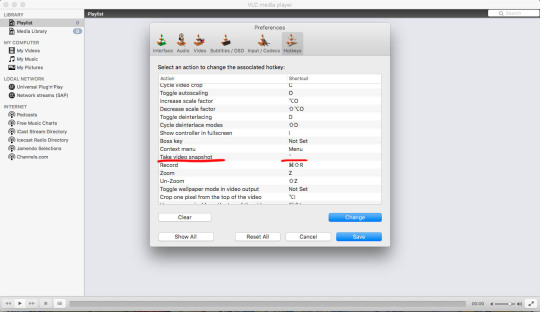
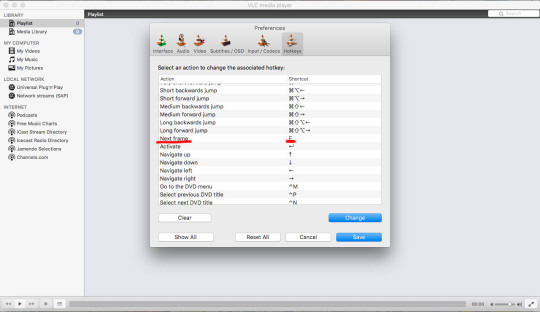
When making a gif, you’ll obviously need to have a file of whatever you wish to gif (since I’m an OP blog I’ll stick to using OP as an example). The website to torrent these from is nyaa.si. This is what it looks like:

(Me being the horrible OP nerd that I am have all episodes and movies downloaded....)
Once you have the desired episode you want, open it up in VLC.

Once you reach the part you want to gif, click your ‘Take video snapshot’ hotkey. This is what should appear once you do so:

Next, you’ll have to click your ‘Next Frame’ hotkey and go through all the frames, snapshotting the ones you desire. I know it’s a really long and tedious process, especially if you’re doing large gif sets but it helps in the long run. Chuck on some tunes as to not get bored!
All of your frames will save in the desired folder, with the frames being individual images.
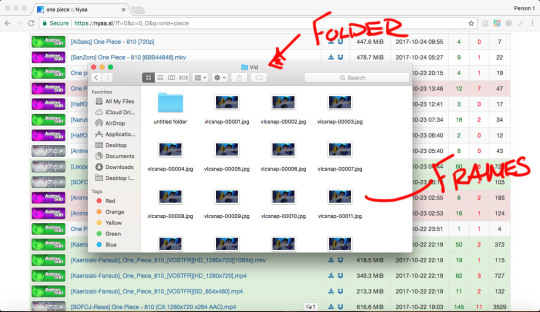
Now to put them together! Open up Photoshop and go to File>Scripts>Load Files into Stack.
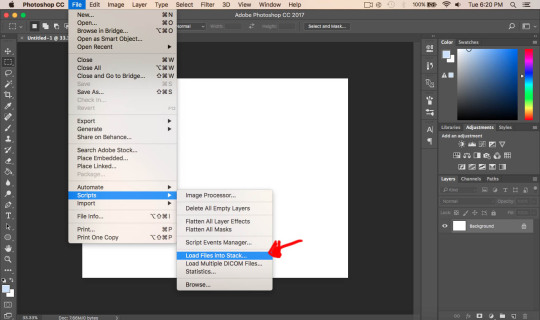
Don’t go to Import>Load files into frames (or something like that) as this makes the whole process a lot more difficult. When going through this way, you are only limited to 500 frames which can limit what you’re working on (especially if it’s a large gifset with more than 500 frames). When importing through Scripts, it will allow you more than 500 (I haven’t hit a limit yet so I’m not sure if there is one or not but so far I haven’t experienced one).
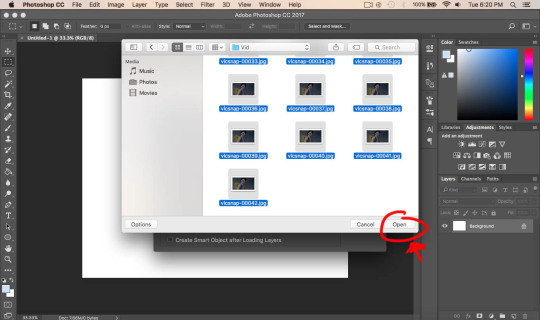
Click ‘Browse’ and find the folder with your frames, selecting all of the ones you wish to convert into a gif and click ‘Open’ and then ‘Ok’. It should look something like this:

Next, we want to display the ‘Timeline’. To do this, we have to go to Window>Timeline
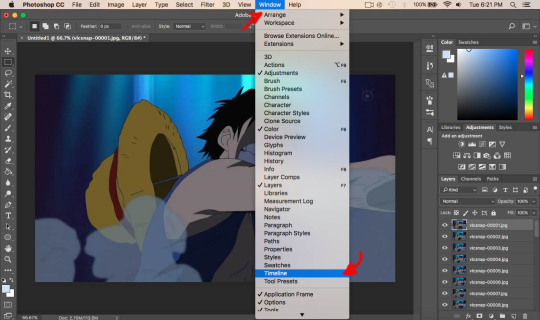
A grey box should appear on the bottom of your page. Click the little arrow where it says ‘Create Video Timeline’ and click ‘Create Frame Animation’
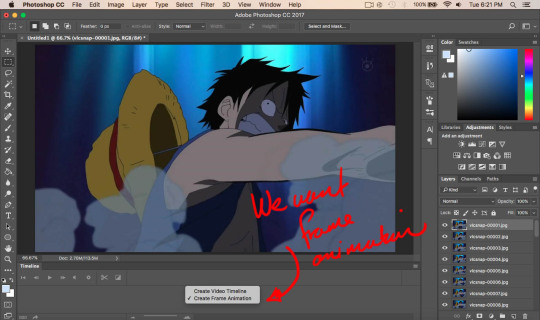

When done, click on the little box to the right hand side of the timeline window and click ‘Make Frames From Layers’.
Because of the size of the file, it’s too big and is lagging down Photoshop a bit, plus we need to adjust the sizing for Tumblr. To do this, go to Image>Image Size
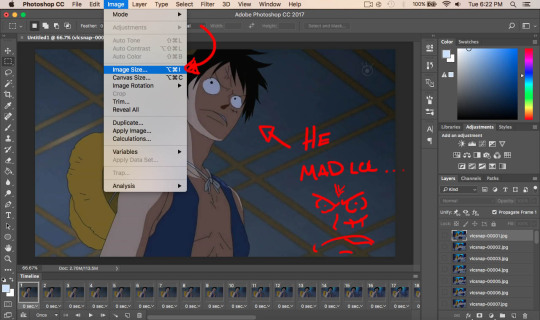
Make sure that the width is at 540 pixels (not cm, inches, etc.) if you want a standard size. (I don’t remember the exact dimensions for Tumblr but if you want to know, do a quick google search). Also be sure to click the link to ensure it is fitted proportionately and click ‘OK’ once done.
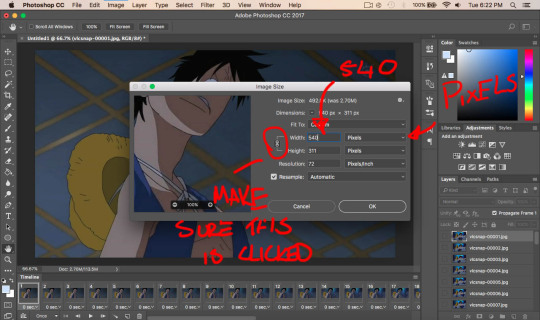

Once again, click the little dropbox on the top right hand side of the timeline window and click ‘Reverse Frames’ (only if your frames have loaded backwards which mine always do although this may be different to you, to check just play through the frames)
Play around with timing to how you wish. I usually have mine at ‘0.08′ seconds. You can change the time down next to the small arrow where it has ‘0.00′ (Make sure all frames are selected if you want all frames to have the same time delay) Remember that when played at 0.00, it may appear normal but once saved it is a lot faster so be sure to change it
Now we want to select all frames in both the timeline and in the layers, this is important for the next step. Once selected, click the small icon at the bottom of the the left hand corner (next to ‘Once’)


Once this is converted to a video timeline, go to Filter>Convert for Smart Filters. This essentially merges all your frames/layers together and still plays as a video in the timeline. It also allows us to edit the batch of frames together instead of going through each individual frame to edit it.
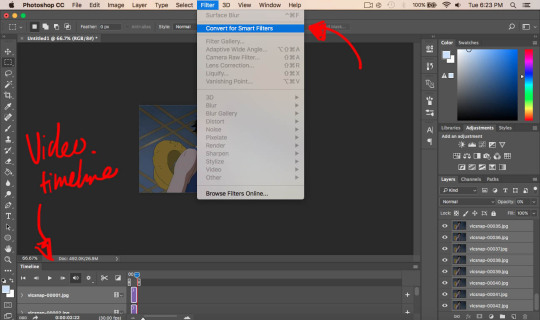
This bit of editing really helps blend colours together which helps in saving them later on. It does get rid of details here in there depending how you apply it. Go to Filter>Blue>Surface Blur and experiment around with the settings.

I usually keep mine at Radius: 5 and Threshold: 10. I recommend not going too far from these numbers.

Because the surface blur has blured the colours together slightly, the defining lines of the character are slightly lost. To fix this we go to Filter>Sharpen>Smart Sharpen.

I tend to keep my radius quite low and the amount relatively low as well, it depends on the gif I’m making.

I tend to see this a lot when people make gifs and that is that they oversharpen their frames which can be quite jarring to the eye and it also doesn’t look very nice. An example of oversharpening is when white pixels surround the black like this:
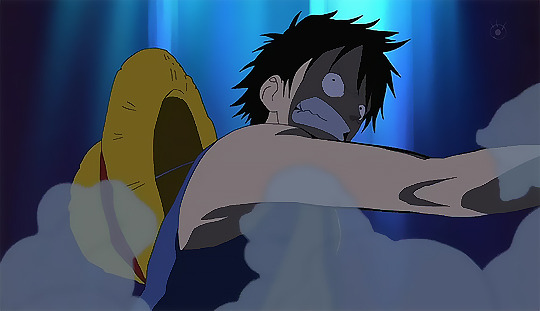
Less oversharped but still so:
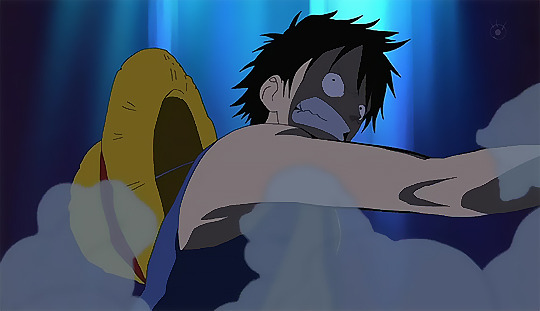
It makes the lines all jagged and unsmooth which is what we want to avoid.

That’s a lot better (and it could be better but notice the distinct lack of white pixels)
Now you can play around with different filters and such! I definitely recommend using some sort of filters, the anime colours are very dull and unsaturated. Once you’re happy, save your gif by going to File>Export>Save for Web
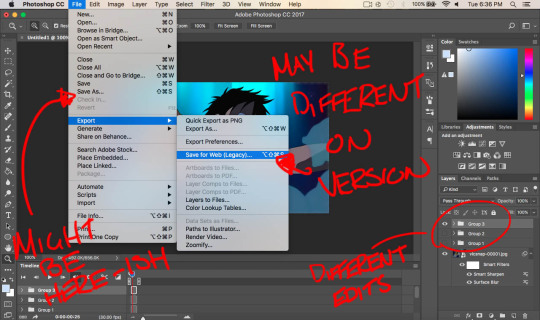
This is what the next window will look like. You can experiment with either Diffusion and Pattern. This is how the pixels on your gif will appear. I usually alternate between the two, depending on what works best with the particular gif I’m making. In this case, I’ll use Diffusion.
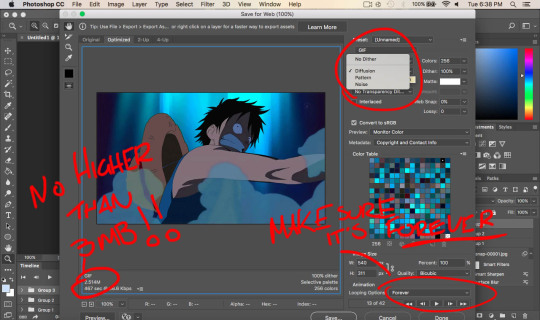
When saving, make sure that the size of the gif is no higher than 3mb, that is tumblr’s restriction on the size of gifs (as of making this tutorial). Also make sure that Looping Options is selected as ‘Forever’. Click ‘Save’ when you’re done! And there you go, you have your gif!
Filter 1:

Filter 2:
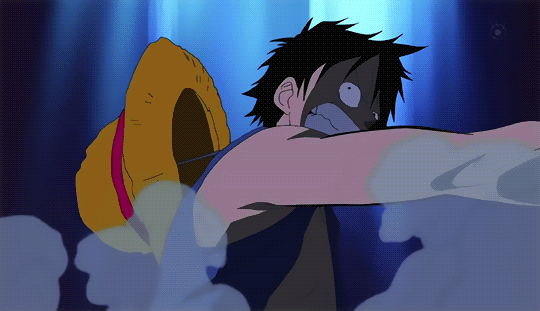
Filter 3:
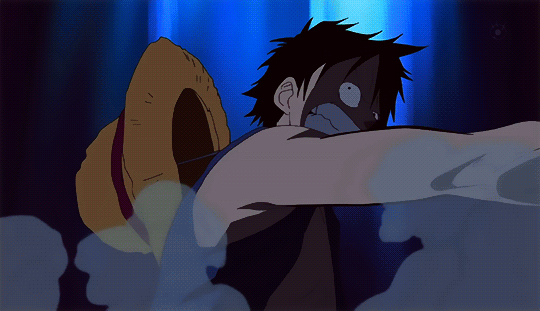
Anime:
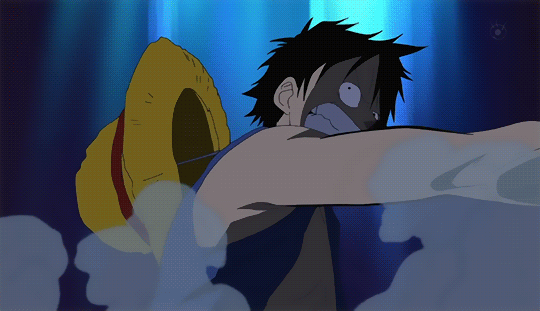
Notice the different palettes you can create? If you only wanted to make a gif, you’re done! However, if you want to know some more tricks, keep on reading! (I say as if this tutorial isn’t long enough)
This part is if you want your gifs to look more clean and crisp.
If you notice in my example gifs, they all have these square like patterns on there. That’s because Photoshop can only allow 256 colours, so to make up for those lack in colours, it adds pattern/diffusion to essentially replace them (or something like that lol)
To fix this, go back to your gif (before saving) and select the lasso tool and select the colours that are most important in the frame.

Once done, click Image>Mode>Indexed Colour (make sure you have the history window ready)
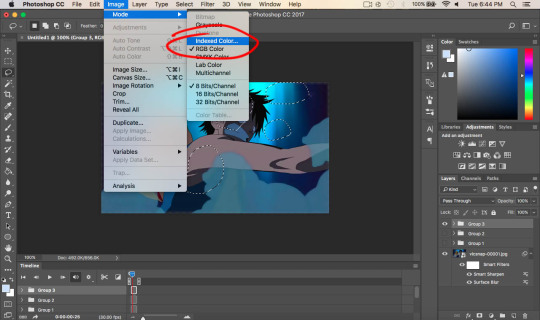
Make sure your settings are set like this (they may be by default but I don’t remember) and click ‘OK’

Now go back and save it as if you were saving it as a gif by File>Export>Save for web. This time, click the drop box and click ‘Save Colour Table’ and call it table. It will ask if you want to replace it, click ‘OK’. Once saved, click cancel and return to your gif.
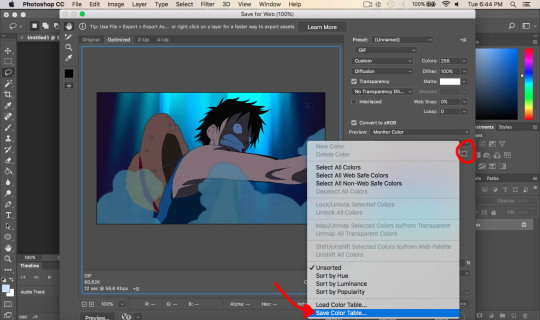
Click on the history window (if it’s not there, look under ‘Window’) and undo the ‘Indexed Colour’. When we did this, the layers all merged together and the frames have gone, meaning no more motion/movement. Make sure to undo this step!

Click the same little icon when we were saving the colour table and click load table, and select ‘table’. Similar colours will come up however now they are the most important ones. Play through the gif to ensure the colours look nice and look smooth. if not, delete some colours on the colour table by selecting the colour you wish to delete and the little trash can in the bottom right hand corner. To add colours, go to the ‘original’ tab and select the colour picker, clicking the little page icon left of the trash can. This will add the colour to the table.
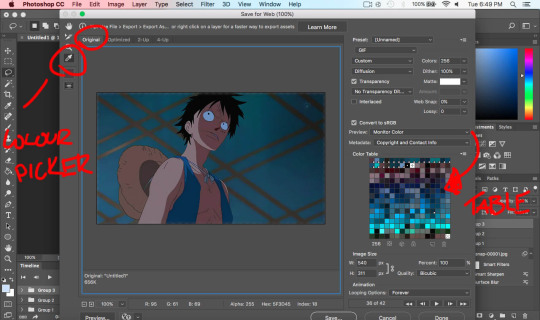
This can be incredibly tedious but it changes the colours on the gif and makes it look as if it is straight from the anime. Gifs like this one needs a lot of time since the colours in the back change quite a lot.
Before:

After:
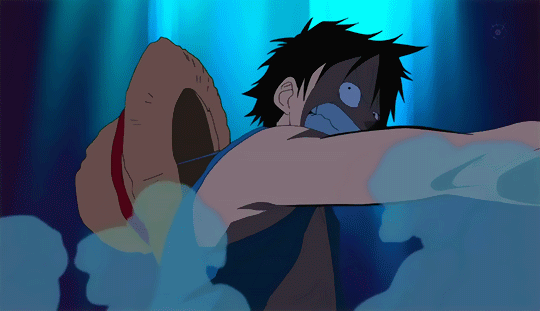
It may not look like much to those who don’t make gifs (or any difference at all) but things like these can help increase the quality of the gif. It seems like a really long and tedious process (to which it is trust me) but I think it’s worth it in the end!
For comparisons sake, here’s diffusion (first) compared to pattern (second)

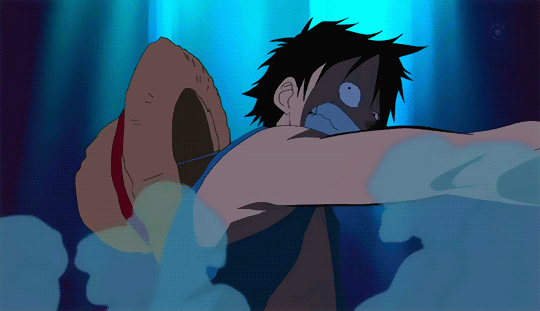
If anyone has any questions regarding this tutorial, feel free to message me and I can try help you out!
If you read this far, thank you so much! I spent a lot of time on this tutorial so I’m grateful if you took time out of your day to read this. Have a good day!!
#gif#tutorial#anime#opgraphics#one piece#monkey d. luffy#GOD#this took 3 hours to make#more than that#I'm lowkey embarrassed#oh well#I hope it wasn't too confusing#but yeah making gifs is tiring#blegh#mine
62 notes
·
View notes
Photo
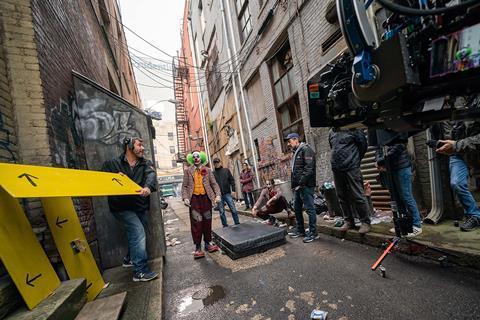
CINEMATOGRAPHY OSCAR NOMINEES ON AUTHENTICITY AND AVOIDING VFX https://ift.tt/2OZteQ0
The DoPs behind 1917, Joker, The Irishman, Once Upon A Time… In Hollywood and The Lighthouse reflect on the bold choices they made to bring dynamic visions to the screen.
Cinematographers are moving both forward and backward in technological terms this year, ironically in pursuit of the same goal: authenticity.
Avoiding VFX and instead opting to shoot reality has been a central theme. Robert Richardson used real Los Angeles backgrounds for the driving scenes in Quentin Tarantino’s Once Upon A Time… In Hollywood. Roger Deakins contended with real explosions and fires in Sam Mendes’s 1917.
Rigging equipment has also been a common talking point for DoPs in 2019. Deakins pushed the boundaries of stabilising devices to enable extended tracking shots for the continuous-take approach of 1917, while Papamichael explored the limits of large-format cameras, putting them in positions that would have been impossible a few years ago (on a low mounted arm attached to a racing car, in one case). Perhaps most complicated of all was Rodrigo Prieto’s “three-headed monster”, a three-camera set-up used to aid the CGI de-ageing process for Martin Scorsese’s The Irishman.
These and other top cinematographers no longer debate analogue versus digital, with plenty saying it is digital and film, rather than digital or film. This is in part due to rapid advances in camera technology by companies like Arri, with films including 1917 utilising a large-format digital camera that, according to Deakins, is as good as any film camera.
Mixing light sources has also been in vogue, with Lawrence Sher using harsh fluorescents and urban streetlamps to create the heightened eeriness of Joker and grittiness of the city.
Whether they are using old-school filmmaking techniques or the latest technology, these cinematographers are creating brave new worlds for audiences and their craft.
Lawrence Sher - Joker
SOURCE: NIKO TAVERNISE
LAWRENCE SHER ON THE ‘JOKER’ SET
Lawrence Sher has been known primarily for his work on comedies including Todd Phillips’ The Hangover trilogy, Paul, The Dictator and I Love You, Man, before he reunited with Phillips to create the dark, sinister world of Joker.
While Joaquin Phoenix’s performance threw up regular surprises during the shoot, Sher was a ready and willing partner for the award-winning actor, and says his own work plumbing the depths of the DC Comics arch villain — which won him Camerimage’s Golden Frog award in November — is not as big a departure as it initially appears.
What was the shooting schedule like for Joker?I read the script about a year before, did an early scout in March [2018] and then prepped for 10 weeks. The shoot lasted 60 days with one day of shooting lost due to issues with the LED lighting on the New York City subway sequence.
What was your approach to Joker’s colour scheme?My main colour palette was drawn first and foremost from real lighting fixtures that exist in the city. I also looked at movies of that era in which the movie takes place [1981], the colour of the film stock at the time and how it would capture all of this mixed light. The colour palette is a mix of utilitarian light and uncorrected fluorescents — we kept their crappy look so it wouldn’t be clean.
We changed out some of the streetlights so they would be sodium vapour, as opposed to LED which many streetlights are now. When we shot at dusk, you have that blueish light that mixes with the sodium vapours and suddenly you have the colours that I think people associate with the movie: the blues, greens, oranges and greys. You can see the messiness of the city.
How did you approach working with the actors to capture their performances?On set we maintain a certain rhythm for the actors. If they have to go back to trailer, even for 20 minutes, there is a momentum loss. So if I can shoot fast, they never have to leave the set. It helps everybody, especially the scene.
Todd Phillips encouraged improvisation, for instance the bathroom scene where Joker starts to dance after killing the men in the subway. Did that approach affect the shooting?That shot was improvisational. He was going to come into the bathroom, hide the gun, wash off the make-up and stand in the mirror and laugh. But with Todd, the movie is constantly being rewritten so you are discovering it as you make it. All of the planning is there but he’s always flexible. With that scene, he wanted to try it non-verbally. He played a piece of music — he didn’t tell the camera operator what was going to happen — and we got that scene in one take.
Was your approach to Joker different to your other films?My lighting approach is not any different. We are not servicing comedy [in Joker]. Some of the compositions come to the forefront perhaps, more than in my previous works. But my approach, particularly with Todd, is to allow for flexibility and freedom. A lot of it is co-ordination with production design and needing the freedom to be able to light a big space. To have the world lit as opposed to focused on a specific person on a mark.
Which sequence was the most challenging to shoot?The subway scene where he kills three Wall Street guys. We shot on a stage and with LED panels. It was challenging because while we had more money than other independent films, it’s still a budget issue. Todd had always described it as a fever dream — this kind of escalating light show. We accomplished it with a very expensive row of LED lights on both sides, though not too many LEDs because we tried to keep to the light as they had it in the 1970s and ’80s. I was taking the New York subway all the time and shooting with my iPhone to figure out the lighting for that scene.
How did you find working with Joaquin Phoenix?It was a transformative experience watching him act and getting to know him. I didn’t say anything to him during prep; he was a little bit intimidating. He apologised to me for acting weird and I said, “No man, do your thing.” We grew to have a good relationship, where we would challenge each other with the choices on set.
Rodrigo Prieto - The Irishman
SOURCE: NIKO TAVERNISE PICTURES
RODRIGO PRIETO WITH MARTIN SCORSESE ON THE SET OF ‘THE IRISHMAN’
Mexican cinematographer Rodrigo Prieto has worked alongside acclaimed directors including Alejandro Gonzalez Inarritu (21 Grams, Babel), Ang Lee (Brokeback Mountain) and Pedro Almodovar (Broken Embraces). The Irishman marks his third feature with Martin Scorsese, after The Wolf Of Wall Street and Silence.
Prieto describes the epic crime drama as one of his most challenging projects to date: an intensive 108-day shoot involving more than 300 set-ups, with the added challenge of managing a complicated CGI de-ageing process for the main actors, which incorporated a “three-headed monster” camera rig.
Although Martin Scorsese is an avid supporter of shooting on film, you had to use digital as well to achieve the de-ageing technique.Yes, 56% was shot on digital and 44% on film. The overall look I thought had to be based on film negative because of the memory aspect. Scorsese talked about home movies, this sensation of remembering the past through images, so I developed looks based on still photography, Kodachrome and Ektachrome.
For the visual effects, it was necessary to shoot with digital cameras where the face had to be replaced with CGI. Visual-effects supervisor Pablo Helman from Industrial Light & Magic needed three cameras synched for every angle and the shutters had to all be in perfect sync. The challenge of getting three cameras to move in unison meant that using film cameras from a practical standpoint was nearly impossible.
Was it Pablo Helman who came up with the idea of using CGI to de-age the actors?Yes, when we were shooting Silence, Pablo said he thought there was a way to make actors look younger through computer-generated imagery. He came up with a three-headed rig where the central camera, the Red Helium, is capturing the shot and two witness cameras, Arri Alexa Minis, are sat on either side of the main camera to read the infrared map of the actors’ faces. We called it the “three-headed monster”.
Can you talk about the stages of the de-ageing process and how that was achieved?There are several different stages. Prosthetics were used to make the actors look older. Make-up could make the actors look younger, for example making a 70-year-old actor look like they were in their 50s. VFX and CGI de-ageing were used when the actors are close to the transition to make-up, and that was complicated as the ageing transition was subtle, say, only a few months in time rather than several years. The technical and make-up teams had to be sure the transition was smooth.
How did you map out the visual arc of a film that spans five decades over three-and-a-half hours?We did not want to make it over-stylised or flashy. Scorsese wanted the camera to reflect the way Frank Sheeran [played by Robert De Niro] approached his job, which was simple, methodical and repetitive. The audience sees the same shots with Frank — the camera pans around at the same angle. When we were with other characters, like crazy Joe Gallo, the camera behaves differently.
How did the fact the film was made to screen first and foremost on Netflix affect the way it was shot?For the most part it wasn’t a consideration. Scorsese designs his shots in a way that helps the story. The one thing we did change was the aspect ratio. Normally, Scorsese would use widescreen but in this case we thought we had better use 1.85 because it would fill up home screens. It also fit Frank’s personality more, as well as helping to show the height difference between the characters. Frank was a tall man so we made special shoes for De Niro and boxes with cushions where he sat. For accuracy, we also changed his eye colour to blue.
You were working on a tight schedule. Was there any room for improvisation during the shoot?When the actors want to try something different, Scorsese will almost always go for it. Near the end of the film, Frank is looking as his car is being washed and it’s a defining moment. We lit the scene for him standing and always looking at the car. Then De Niro said, “I always kind of imagined being inside the car.” So Marty said, “Oh, OK, let’s do that.” I had to set it up in three seconds. As soon as we shot it, I could see that his performance was there.
Jarin Blaschke - The Lighthouse
SOURCE: CHRIS REARDON
JARIN BLASCHKE ON THE SET OF ‘THE LIGHTHOUSE’
Born in the Los Angeles suburbs, Jarin Blaschke continues a collaboration with filmmaker Robert Eggers that began on the latter’s 2008 short The Tell-Tale Heart and encompassed his haunting 2015 feature debut The Witch. For The Lighthouse, the pair conjured up another strange and foreboding world: a mysterious New England island in the 1890s, inhabited by lighthouse keepers Robert Pattinson and Willem Dafoe. Blaschke deployed innovative lighting and lensing solutions to take on not just the wilds of authentic Nova Scotia locations, but the demands of dark, cramped, wet settings.
How many years did it take to develop the concept of The Lighthouse?I didn’t have a script until a month or two before prep, but Rob first pitched this idea probably three years before that. With him, it starts with atmosphere, so my subconscious was working on the atmosphere at the same time that we were developing The Witch. We didn’t know which one would go [first] and then The Witch happened.
The Lighthouse was shot in black and white, with a 1.19:1 aspect ratio, on Kodak Double X 35mm film format, which dates from the 1950s. How much testing did you do?There was a battery of tests I put myself through, like testing real oil lamps to see how to do it with an electrical lamp. I had to know how to light differently: I bolstered the light levels by 15, sometimes 20 times, and the film stock had to be tested in rain, backlit to know where it looks like night but also doesn’t look overly lit.
What logistical challenges did you face shooting on location in Nova Scotia?The weather was bad and added about four days to our schedule. It could have been worse but we had a covered set. We couldn’t do a night scene one night because it was too windy and even with day scenes, you have frames where you need to bounce light back using a giant sail and it gets a little hairy. There was a lot of eating cold porridge in the dark in the morning and the breakfast tent was going to blow away. We had to build this hardcore tent just to have breakfast. It adds to the movie, I hope.
In exploring the space between reality and insanity in The Lighthouse, did you use special lenses for certain scenes?I went to Panavision. I know vintage lenses are really trendy right now. I had some experience with the usual suspects: Cooke Series 2s and Super Baltars [used in The Godfather and The Birds]. They put original Baltars in front of me and I fell in love with them. So we had old Baltars from the 1930s. We used the first high-speed portrait lens of the 19th century for special shots, like [Robert Pattinson] having sex with a mermaid, the hand going down the body. Stuff that was super heightened where we could get away with it.
How did your collaboration with Eggers inspire you for certain images?I’ve known Rob for 12 years so I knew there were going to be a lot of symmetrical two-shots. There is one direct reference to a Sascha Schneider painting. And the last scene in the film is in the lookbook. Those are the only two references, everything else I tried to create. I know Rob watched all kinds of crazy stuff, like videos with shark genitals.
You are also working on Eggers’ next film, The Northman. What can you say about it?Rob says very little. It’s a bigger movie than the others. I can say it’s a Viking revenge movie and we are shooting in Europe. I think he feels a responsibility to do a trilogy. It’s dark and unusually violent.
Robert Richardson - Once Upon A Time… In Hollywood
SOURCE: ANDREW COOPER
ROBERT RICHARDSON WITH QUENTIN TARANTINO
A nine-time Oscar nominee and three-time winner, Robert Richardson’s career has been closely associated with three filmmakers: Oliver Stone, Martin Scorsese and Quentin Tarantino. For Stone, he photographed 11 features in a little over a decade, winning the Oscar for JFK; two of his five collaborations with Scorsese brought him Oscar statuettes (The Aviator and Hugo); and he shared Camerimage’s director and cinematographer duo award with Tarantino for their work across six films including Once Upon A Time… In Hollywood. Richardson is known across the industry for pushing boundaries and doing whatever it takes to achieve a shot.
How would you typify your relationship with Quentin Tarantino?A relationship with a director is a marriage. I have been fortunate enough to forge a series of relationships with all of the directors I’ve worked with from the beginning. It’s the idea that you are linked together and begin to understand how the other speaks, what you like and don’t like. It’s so important. Collaboration at that level is why rock ‘n’ roll bands are the very best when they hold out and play together as the same team as long as they can. The Beatles wouldn’t have been who they were without John, Paul, George and Ringo.
What is your creative process like with Tarantino once you’ve read the script?Quentin was in the room when I first read the [Once Upon A Time… In Hollywood] script. It took me a substantial time to read it. After we had dinner, we made notes and then he played music: ‘Good Thing’ from Paul Revere & The Raiders, ‘Mrs Robinson’ from Simon & Garfunkel, ‘California Dreamin’ from Jose Feliciano. The soundtrack is like a character in the film; it leads you, it is continuously playing from a radio station. The music helped build on the emotion of the characters and the movement of the film.
What is Tarantino’s process for selecting shots?He only shoots on film, he only processes on film and he only watches dailies on film. He doesn’t see digital replication until he gets to the Avid in the editing room. Our process is to shoot a film chemically, process and print chemically, and that print is duplicated on a 35mm projector. You then project the film as well as the digital intermediate, and they need to replicate each other perfectly, otherwise Quentin doesn’t want to discuss it. It’s definitely challenging, but that’s how we get to be better artists.
And when filming, Tarantino always sits beside the camera?Quentin is a director not a selector. He sits beside the camera. There is no video village, there is no video replay. You don’t go back and look at something. He watches the actors and their performance. If he’s got it, it’s over. If there is an error, something happened or an actor needs a retake, he will listen to why, but he will always choose in the editorial process the very best performance. The film is golden in its use of warm, saturated colours. We wanted to make a film that was about California and sunshine. On my side, it’s a combination of film stock, lenses and light. For the golden exteriors, we used a combination of Panavision’s anamorphic lenses and golden lenses.
You are known for using myriad film stocks to achieve different looks. What did you use for this film?We shot 35mm anamorphic, except when shooting Rick Dalton’s western television series, then we were 35mm black and white, and we shot with spherical zooms mostly in 1.33. There were also two sequences at Sharon Tate and Roman Polanski’s home that we shot on Kodak Ektachrome, one in 16mm black and white and the other on Super8mm colour.
Roger Deakins - 1917
SOURCE: FRANÇOIS DUHAMEL/UNIVERSAL PICTURES AND DREAMWORKS PICTURES
ROGER DEAKINS ON THE SET OF ‘1917’
Winner of four Baftas and an Oscar (secured last year for Blade Runner 2049 on his 14th nomination), the prolific Deakins has been an influential figure in cinematography since he burst on to the scene with 1984. On that film he pioneered a bleach bypass process to achieve a washed-out look that went on to be used in films including Se7en and Saving Private Ryan. He has also been at the forefront of embracing digital filming methods, not least on Sam Mendes’s Skyfall.
He reunites with Mendes on 1917, which follows two soldiers on a mission to avert a strategic disaster during the First World War. Deakins and Mendes had to invent new ways to move the camera to create the impression that the narrative was unfolding in a single, continuous shot — an innovative feat that puts the audience on the frontline.
How did you achieve so much fluidity in single camera shooting?We used a lot of different rigs. Probably 60% of the film was shot on a stabilised remote head. Some shots are done on the Trinity [Arri stabiliser rig], some are done on the conventional Steadicam and there’s even a drone. But the majority of the film is done remotely with a stabilised head that’s either carried by the grips or a tracking vehicle on the end of a crane or on a wire.
How did you plan such incredible camera movement while keeping up the illusion of one continuous shot?Sometimes it’s put on to a wire and then moved, or it’s taken off the wire and then someone carries it or runs with it so it all becomes one shot. The reason was not only to sustain the scene but also that we didn’t want to cut in some of the obvious places.
Were you pushing the existing technology, or did you have to create new methods?We created some of our own. For instance, running with speed down a trench in front of two characters like we were, you can’t do that on Steadicam. So a Steadicam operator came up with the design of little mini-posts with gyros on them, and we put a very small remote head on top. He would run down the trench facing forward with the camera facing backwards over his shoulder, which I was remotely operating. Then he’d get to a corner in the trench and segue around so he started on a front shot.
How did you communicate with the operating team on the ground?I’d be operating remotely. I don’t like wearing earphones because I’m constantly running to and from the set talking to grips or whoever. James [Deakins’ wife and digital workflow consultant] would be on set wearing earphones and relaying messages to the crew. During a shot, she would say things to the operating team like “faster, faster” or “you are getting too close, a little to the left”. It helped because they couldn’t see what the camera was seeing.
How integral were the four months of rehearsals?The trick was for Sam and me to figure out what we wanted to do: where we wanted the camera and to finesse the camera moves relative to the actors. We tested specific rigs on specific kinds of shots. That was the big trick, really, practising with different pieces of equipment. We also went to Salisbury Plain and mapped out all the shots we wanted before anything was dug or built, such as the farmhouse.
How was the weather integral to the film?Being such an exterior movie, we were very dependent on the light and the weather. And we realised you can’t really light it. If you were running down a trench and turning around 360 degrees, there’s nowhere to put a light. Because we were shooting in story order, we had to shoot in cloud to get the continuity from scene to scene. Some mornings the sun would be out and we couldn’t shoot so we would rehearse instead.
The shooting in 1917 had to be in sync with the editing. How did that process work?Sam had to choose the take he wanted before we did the next shot because we had to match them, like the beginning of the B side had to match the end of the A side. That frame and the camera movement and the position of the actors had to match exactly. We would have the take on playback, and set up the incoming take and keep playing the beginning to match the end of the shot. That’s the great thing about video assist and being able to overlay the two images.
You were one of the early adopters of digital shooting. What won you over?
The Arri Alexa tipped the point for me between film and digital. I find it a bit of a non-argument. I think it’s what’s in the frame and where you point the camera.
0 notes